 Back in early 2013, an email discussion among friends turned into a realization. We were having the same tired discussions about gender bias, over and over. The details might vary slightly, but it was the same story, again and again, and nothing was changing. It was time to go public and start looking for solutions. We began by inviting others to join our discussion.
Back in early 2013, an email discussion among friends turned into a realization. We were having the same tired discussions about gender bias, over and over. The details might vary slightly, but it was the same story, again and again, and nothing was changing. It was time to go public and start looking for solutions. We began by inviting others to join our discussion.
We think the journalism community could use more women voices. We know that this can be uncomfortable to discuss out loud–you’re accused of being militant, bitchy or bitter. But it’s time to move beyond the good old boys club. The question is, how? How do we get more female bylines into the big magazines? How do we get more women on the mastheads? How do we get our work taken more seriously? And how do we do this without sounding like complainers? How do we get women working together on this? And how can we recruit some men to the cause?
We don’t have answers, but we’d like to start a conversation.
That initial conversation spurred a proposal to hold a public discussion at the 2013 National Association of Science Writers meeting. In the meantime, a sexual harassment scandal rocked the science writing community, and our panel at Science Writers 2013 meeting was moved to the ballroom before a standing room-only audience.
We presented data on gender bias in our community, discussed sexual harassment, and recounted times when our ideas went unheard or were not taken seriously until they came out of the mouth (or pen) of a man. Attendees stood up to share their own stories, and people of all genders approached us to ask, “How can I help?”
The next step, we decided, was to develop some plans to change the status quo. So organizers of that original NASW panel — Deborah Blum, Maryn McKenna, Kathleen Raven, Florence Williams, Emily Willingham and I — applied for and received an Idea Grant from NASW to hold a working summit to come up with solutions. Tom Levenson and Seth Mnookin joined us and offered to host the summit at MIT.
The first Women in Science Writing: Solutions Summit took place at MIT on June 13-15. The events began with an evening keynote from Caryl Rivers, author of The New Soft War on Women. [A link to Bethany Brookshire’s summary of the speech will be posted here soon.]
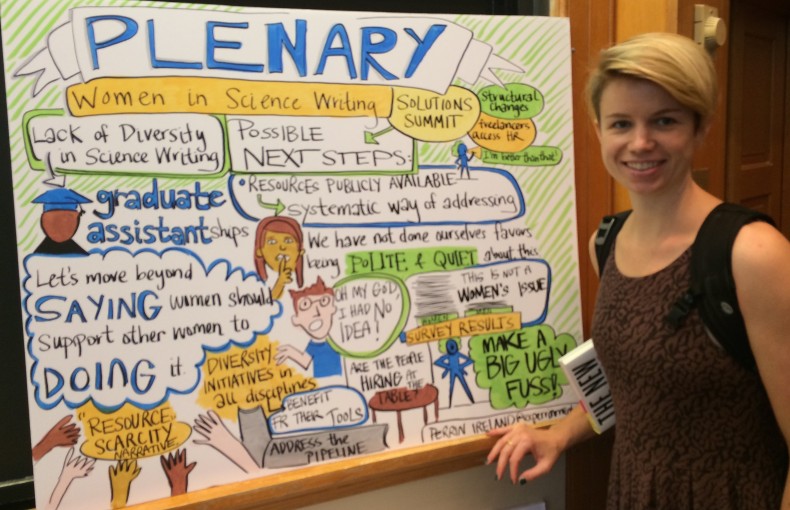 The next morning, we began by defining the problems. Deborah Blum presented data on bylines, salaries, masthead positions, awards and other types of recognition in the science writing world (collected by Karen Hess and Aparna Vidyasagar, graduate students from the University of Wisconsin-Madison), and Emily Willingham unveiled the results of our survey on gender bias, harassment, and related issues. More than 500 people responded, and we’ve posted the data here. Go have a look.
The next morning, we began by defining the problems. Deborah Blum presented data on bylines, salaries, masthead positions, awards and other types of recognition in the science writing world (collected by Karen Hess and Aparna Vidyasagar, graduate students from the University of Wisconsin-Madison), and Emily Willingham unveiled the results of our survey on gender bias, harassment, and related issues. More than 500 people responded, and we’ve posted the data here. Go have a look.
A few highlights:
-While women far outnumber men in science journalism programs, men consistently outnumber women in the newsroom. Only 35% of technology articles and 38% of science stories are written by women.
-Women equal or outnumber men in staff positions with the word “editor” in the title at American Scientist, Discover, Popular Science and Scientific American, but women are not well represented in “contributing editor” and “editor in chief” positions.
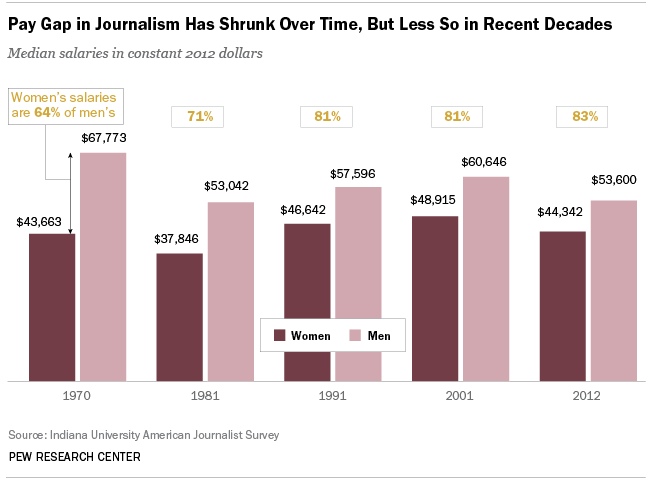
-The salary gap is not closing. From 1970 to 1991, women’s salaries rose from 64% of men’s salaries to 81%. But since then, little has changed. In 2012, women’s salaries remained just 83% of men’s.
-Between 2009 and 2013, 80.8% of the contributors to the Best American Science Writing were men.
-No woman has won the Royal Society Winton Prize for science books since 1988.
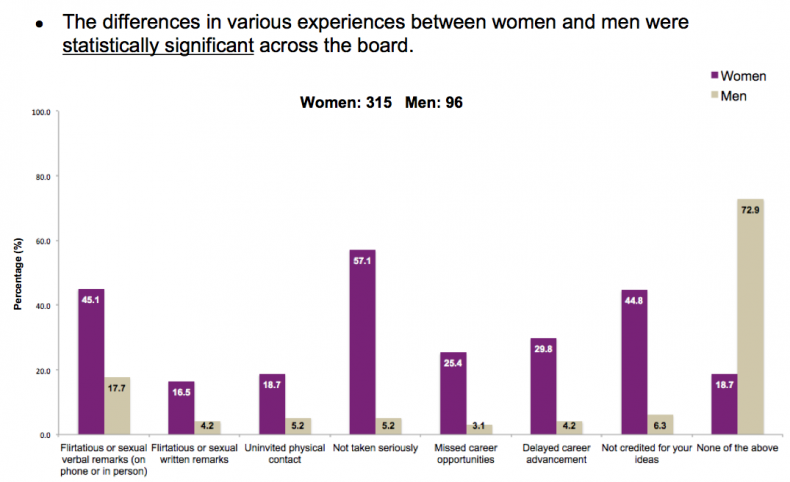 -Many women struggle to be heard and acknowledged — 57% of the 315 women who responded to our survey said they had not been taken seriously, and 45% said they’d not received credit for their ideas.
-Many women struggle to be heard and acknowledged — 57% of the 315 women who responded to our survey said they had not been taken seriously, and 45% said they’d not received credit for their ideas.
-Does gender bias exist in science writing/journalism? 54% of women and 44% of men surveyed said yes (27% of women and 29% of men were unsure).
-While respondents agreed that some behaviors, like sexual advances, were clearly harassment, there was less agreement on others, such as jokes, and written comments suggested that harassment is hard to define and depends on context.
-Women continue to face harassment — 38% of women reported being harassed on the job, compared to 8% of men.
-Women and men most often experienced harassment from their subordinates, and two women reported being harassed by sources.
Training Sessions
After the plenary session, attendees broke into smaller groups to take part in training sessions on sexual harassment (led by consultant Debora Bloom) and workforce diversity and inclusion (facilitated by Gwen Cochran Hadden).
The day wrapped up with a discussion about mentoring with panelists Laura Helmuth, science and health editor at Slate; Apoorva Mandavilli, executive editor, SFARI, and Gwen Pearson, science writer and a.k.a. Bug Girl, Wired.com.
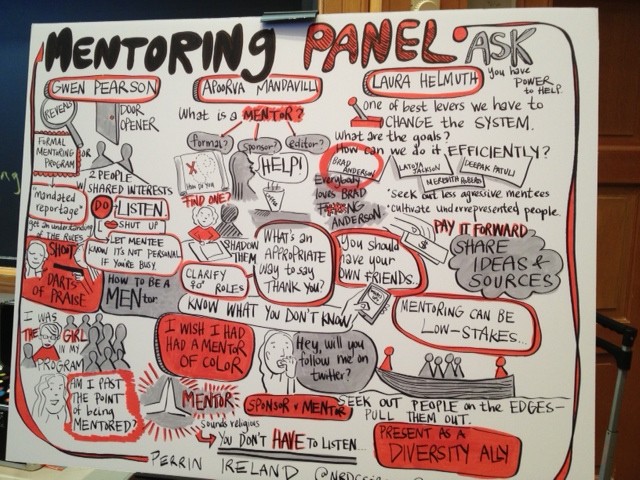
The Summit’s social media guru, Maryn McKenna, created a storify of the discussion, which provides a nice overview and summary.
In a nutshell — don’t wait around for someone to notice you. If you want guidance, you’ll probably need to ask for it. Be persistent, Helmuth said. Studies show that gender (and racial) bias exists in mentoring. In a recent study, researchers sent identical letters professors at top universities asking for a meeting to discuss research opportunities. Professors were more likely to respond when the email came from “Brad Anderson” than when it came from a name that suggested the student was female or a minority. “Everyone wants to mentor Brad Fucking Anderson,” Helmuth said.
Mentoring doesn’t need to be formal, Helmuth said. You can start by asking a single question or favor, like a recommendation letter. Mandavilli advised against asking someone, “will you be my mentor?” Instead, seek guidance on a specific issue. Don’t forget to thank your mentor, and when you ask someone to write a letter for you, let them know whether you got the job or fellowship, Mandavilli said. Even if things didn’t go your way, sharing this information could help them craft better letters in the future.
Helmuth advised mentors to praise the writers they mentor when they succeed and don’t take the credit. Mentoring can be good for the ego, she said, but don’t try to make your mentee a mini-me. Mentors should take care to respect boundaries, and remember that mentees are hanging around you because you have the power to help them in their career, not because they’re trying to befriend you. It’s ok for a friendship to develop between mentor and mentee, but “If there is to be friendship, let mentee lead,” Helmuth said.
The summit finished with a half day of work sessions. Now that we’d identified and discussed the problems, we broke into small groups to work on ideas for fixing them. Topics included freelancing, mentoring and being mentored, safety networks, changing the narrative, confronting bias, Wiki it, avoiding tokenism, changing the status quo and creating a science writer’s bill of rights. (Storify here.)
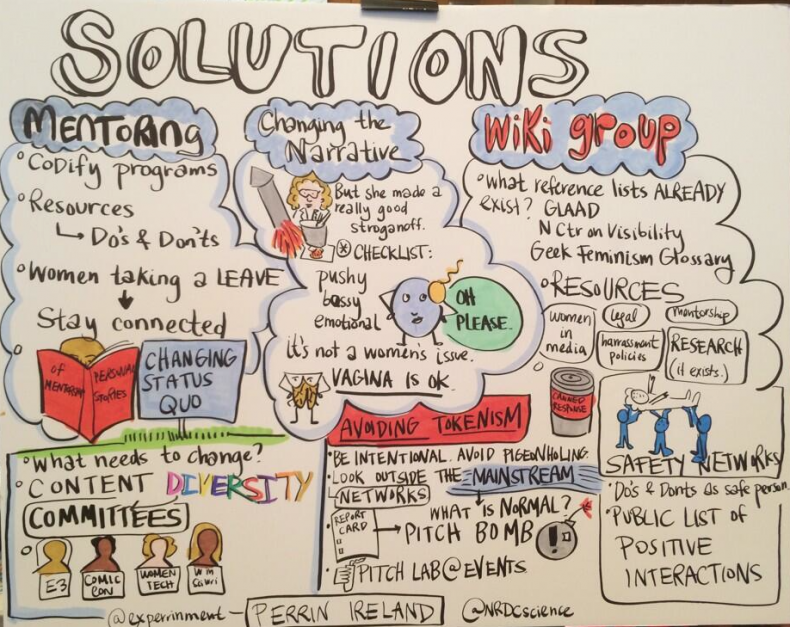
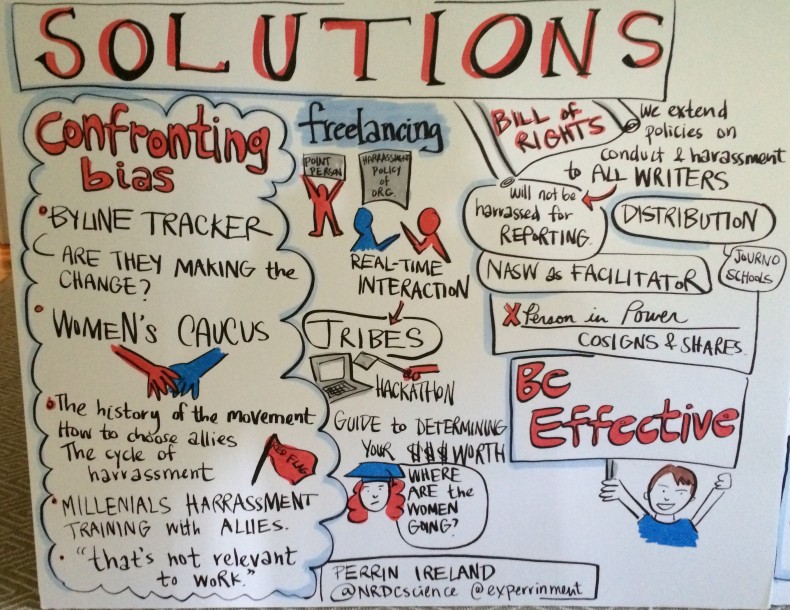 It was inspiring to see how many great, workable ideas people came up with for addressing the many issues we’d identified. Ideas ranged from approaching publications and asking them to include their policies on harassment with their freelance contracts so that freelancers know their rights and what to do if an issue arises, to conducting VIDA-like byline counts and organizing pitch bombs to ensure that publications can’t claim that women aren’t pitching them. The Finkbeiner Test, named after LWON’s very own Ann Finkbeiner, was discussed, as were style guides, harassment training and confidential hotlines to offer advice to people facing harassment or bias.
It was inspiring to see how many great, workable ideas people came up with for addressing the many issues we’d identified. Ideas ranged from approaching publications and asking them to include their policies on harassment with their freelance contracts so that freelancers know their rights and what to do if an issue arises, to conducting VIDA-like byline counts and organizing pitch bombs to ensure that publications can’t claim that women aren’t pitching them. The Finkbeiner Test, named after LWON’s very own Ann Finkbeiner, was discussed, as were style guides, harassment training and confidential hotlines to offer advice to people facing harassment or bias.
We are currently working to put the ideas developed at the summit into a Wiki, which we’ll make public. The science writer’s bill of rights is one of our top priorities, and we hope to finalize that soon so that we can ask NASW and other journalism organizations for support.
As the working groups wrapped up, I was feeling pretty good about what we’d accomplished. But the highlight was still to come. During the final recap, held at the Broad Institute, Alberto Roca leaned over to me and pointed to a Tweet he’d pulled up on the #SciWriSum14 feed:
Images: Photos of working groups and Perrin Ireland next to her visual summary of the plenary session courtesy of Alberto Roca at DiverseScholar.org. Photos of Ireland’s mentoring panel graphics by Laura Helmuth, photos of Ireland’s solutions drawings by Seth Mnookin.
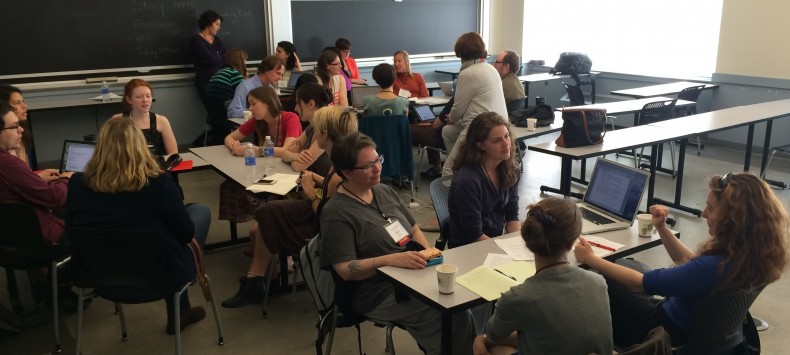
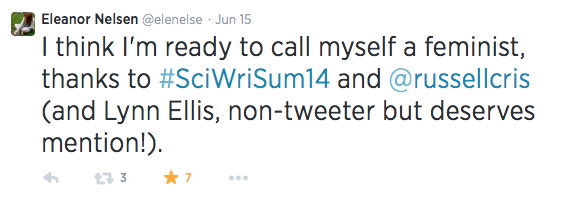
All I see here is the same old presentation of statistics and the same old tired solutions advanced since the 80s.